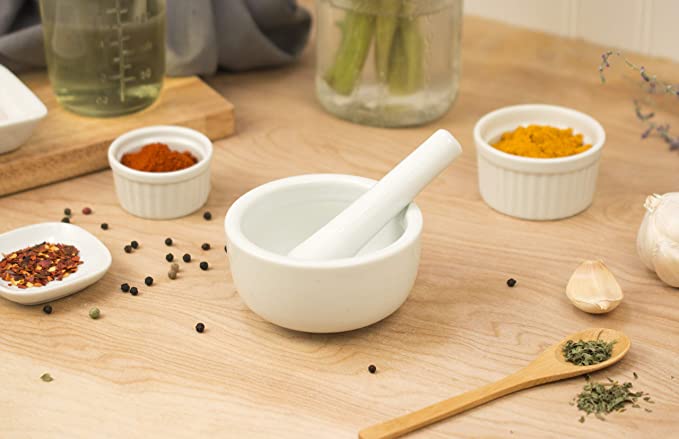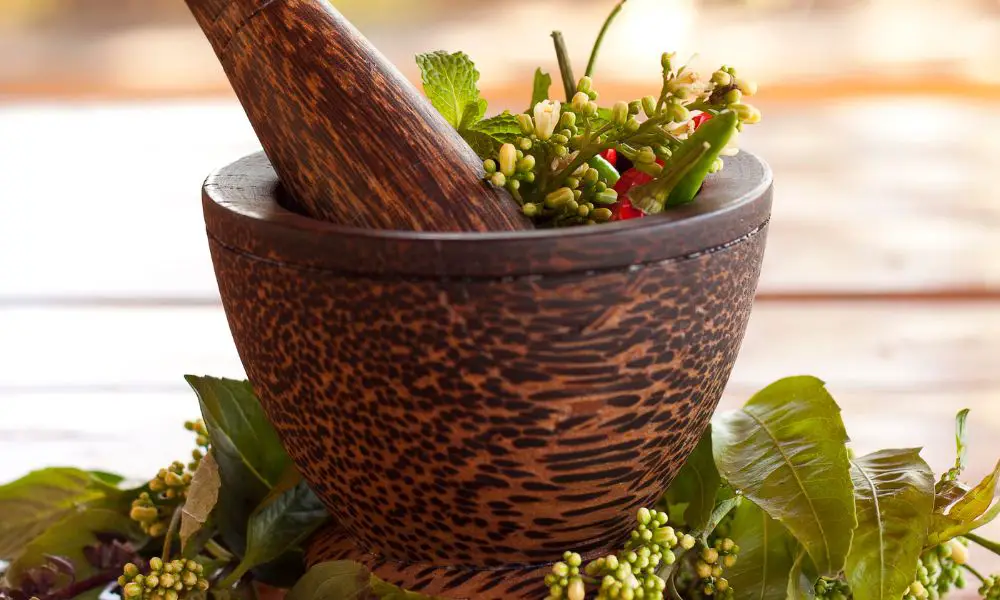This post contains affiliate links. Read the full disclosure here.
Contents
The mortar and pestle have become closely associated with the preparation of ingredients for culinary uses. But this device serves another very important, albeit lesser-known, purpose in the science laboratory.
Scientists use a mortar and pestle to grind solid chemicals into fine powders so that they can dissolve into solvents more easily. Additionally, the chemical reaction rate is a function of particle size, so a mortar and pestle are needed to reduce the sizes of the particles for quicker reactions.
The rest of this article will further explain why mortar and pestle are indispensable tools in a science laboratory and why scientists still make use of them despite all the other alternatives technological advancements offer.
Why Do Scientists Use a Mortar and Pestle?

The mortar and pestle are essential tools in science laboratories, where scientists use them for crushing and grinding solids. There are two key purposes why scientists do this: faster dissolution and faster reaction times.
Let’s look at each of these in more detail:
- Faster dissolution: Solid particulates often have to be dissolved in solvents. The larger chunks take longer to dissolve than the smaller ones. For this reason, scientists need a mortar and pestle to bring down the sizes of solids and speed up the dissolution.
- Faster reaction time: The chemical reaction rate is a function of particle size. Simply put, the smaller the particles involved in the reaction, the quicker they react. So whenever a faster reaction rate is needed, the mortar and pestle take center stage.
The mortar and pestle are ancient grinding tools that may seem out of place in a science laboratory with advanced equipment.
- BUILT GORILLA GRIP TOUGH: the last mortar and pestle you will ever buy, the Gorilla Grip Mortar and Pestle is ultra durable and built tough; featuring a heavy duty grinding pestle that crushes and mashes ingredients effortlessly, the mortar and pestle is ultra durable, and scratch resistant; its heavy base helps keep it in place and resist slipping and sliding, even while crushing the heaviest of ingredients
- 100 PERCENT NATURAL GRANITE: Gorilla Grip granite is sourced from natural granite mines, then handcrafted with care; granite is cut, shaped and polished into the mortar and pestle; natural granite has been used for generations due to its natural durability and long lasting use; no more heavy mixers or food processors, this granite mortar and pestle takes the effort out of food prep while also helps release the natural flavors of the ingredients
- GUACAMOLE, SPICES, NUTS, AND MORE: not just for guacamole, the mortar and pestle is a great option for nearly any ingredient; crush up spices and herbs; create homemade pesto by grinding up nuts and seeds; serve up fresh dips; even a great choice for homemade dressings and salsas; impress your entire guest list with the tastiest dishes ever
- NON SCRATCH BOTTOM: even though the mortar and pestle is heavy duty, it resists scratching countertops and surfaces; it features an optional foam bottom underside that helps protect surfaces, while also helping to prevent slipping and sliding while you prep
- LARGE CAPACITY MORTAR AND PESTLE IS A PERFECT GIFT: mortar and pestle comes in 3 sizes; large size measures 5.2” x 3.2”, weighs 3.9lbs, and holds up to 1.5 cups of ingredients; a perfect year round gift for anyone who enjoys cooking; beautifully designed so that it can be displayed on any countertop and add to the décor of the kitchen
Indeed, there are now electric mortar grinders that are capable of reducing particles to up to 20 times smaller than the resultant particles of manual grinding with a mortar and pestle.
However, it isn’t always necessary to get the particle sizes all the way down. In most cases, a simple mortar and pestle are both efficient and practical.
What Is Mortar and Pestle Used for in Chemistry?
The word “chemistry” tends to conjure up images of beakers and test tubes filled with different solutions. But we would do well to remember that some chemicals also take a solid form and sometimes need to be crushed and ground in order to achieve the right reaction. That’s where the mortar and pestle come in.
In chemistry, the mortar and pestle is used to reduce solid lumps to smaller particulates or finely crushed powders. This helps speed up the processes in the laboratory because the small chunks and powders dissolve faster into solvents than larger lumps of solids.
Additionally, the particle sizes influence the rate of the chemical reaction. The smaller the particle sizes, the faster the reaction.
How To Use a Mortar and Pestle in the Laboratory

The mortar and pestle are often called to use in the laboratory when solids need to be reduced to smaller particulates or completely ground down to a fine powder. As you would expect where science is involved, there is a proper method to doing this.
Here is how you should use a mortar and pestle in the laboratory:
- Prepare the mortar and pestle. Make sure the mortar and pestle are clean before using them. If they have not been properly cleaned after the previous use, there may be some leftover particles from different solids that should not be mixed with the solids you need to crush.
- Place the solid in the mortar. Position the solid lump in the center of the mortar.
- Press the pestle down on the solid. Take the pestle and press down on the lump to apply pressure and crush it.
- Move the pestle in circular motions. Without lifting the pressure off the crushed solid particles, move the pestle in circular motions.
- Check the particles in the mortar. Lift the pestle and examine the particles you have ground so far. Keep doing the fourth step until the particles are as fine as you need them to be.
Conclusion
The mortar and pestle were invented by our Stone Age ancestors. Yet despite the monumental leaps in science and technology since then, these two grinding tools continue to play an important role in the science laboratory.
Although there are now countless machines available that can make light work of crushing and grinding, scientists still turn to the trusty old mortar and pestle for their practicality and efficiency.
Sources
- Britannica: mortar and pestle
- Washington Post: Mortar and pestles for different jobs
- Brainly: In the chemical laboratory, why do scientists use a mortar and pestle?
- Chris Abridge: 204 – Mortar and Pestle
- Home Science Tools: Mortar and Pestles
- Ants Lab: Use of Mortar and Pestle
- Cambridge Enviro: The History of the Mortar and Pestle


